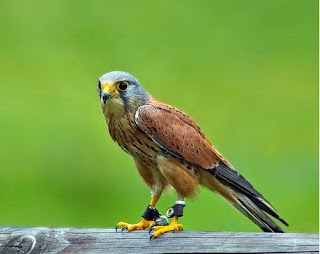

I thought you might be interested in seeing what a “Windhover” looks like. They are also called the Common Kestrel and Eurasian Kestrel. If you can’t tell, the crest (head feathers) are “blue-bleak” in color, the chest is “dapple-dawn” (spotted-tawny), and the back is “gold-vermillion.” So aside from the title, we know Hopkins is talking about this bird. It is the only European falcon that can achieve hovering mid-air while waiting on prey.
In falconry (back in the day), the kind of bird you flew reflected your status in the social system. Below is that system:
- Emperor: Golden Eagle, Vulture, & Merlin
- King: Gyrfalcon (male & female)
- Prince: Female Peregrine
- Duke: Rock Falcon (subspecies of the Peregrine)
- Earl: Peregrine
- Baron: Male peregrine
- Knight: Saker
- Squire: Lanner Falcon
- Lady: Female Merlin
- Yeoman: Goshawk or Hobby
- Priest: Female Sparrowhawk
- Holywater clerk: Male Sparrowhawk
- Knaves, Servants, Children (Chavalier: the lowest title of rank in the old nobility): Old World Kestrel (The Windhover)
Reading Hopkins’ lines, “My heart in hiding / Stirred for a bird -- the achieve of; the mastery of the thing!” I can’t help but think of falconry. But, if Hopkins wanted a bird so bad he could have easily accessed and trained a Sparrowhawk, his priestly right. However, it’s almost as if he knows he shouldn’t want a Kestrel because it’s for the Knaves, Servants, and Children. But as a priest, he yearns to me more like Christ, and the Windhover is an expression of Christ who came and sank below all social status, served the meek knaves, and succored the servants and children.
The Kestrel is also one of the only “hawks” that you can firmly determine sex by color. And Hopkins’ assessment is correct, that this coloration (blue, vermillion, and dappled) confirms the falcon is a “him” and relatively “Him.”
I haven’t read the criticisms about this poem. But, I’d like to take a shot at the last few lines. If we go off the precedent that the falcon is Christ it becomes clearer:
No wonder of it: shéer plód (trudging) makes plough down sillion (ditch work)
Shine (miracles or the Son of God), and blue-bleak embers, ah my dear,
Fall, gall (bitter rancor) themselves, and gash (crucify) gold-vermillion.
I’ve inserted some possible clarifying words in parenthesis. I believe he’s possibly saying, “No wonder then, that Christ who worked in the ditches (this may also refer to Christ’s walk to Calvary) among the low social status, was crucified (gashed) by the people who could not accept that he, “from humble birth,” could “Shine” and be the "Son of God."
But, a Kestrel can hover.

No comments:
Post a Comment